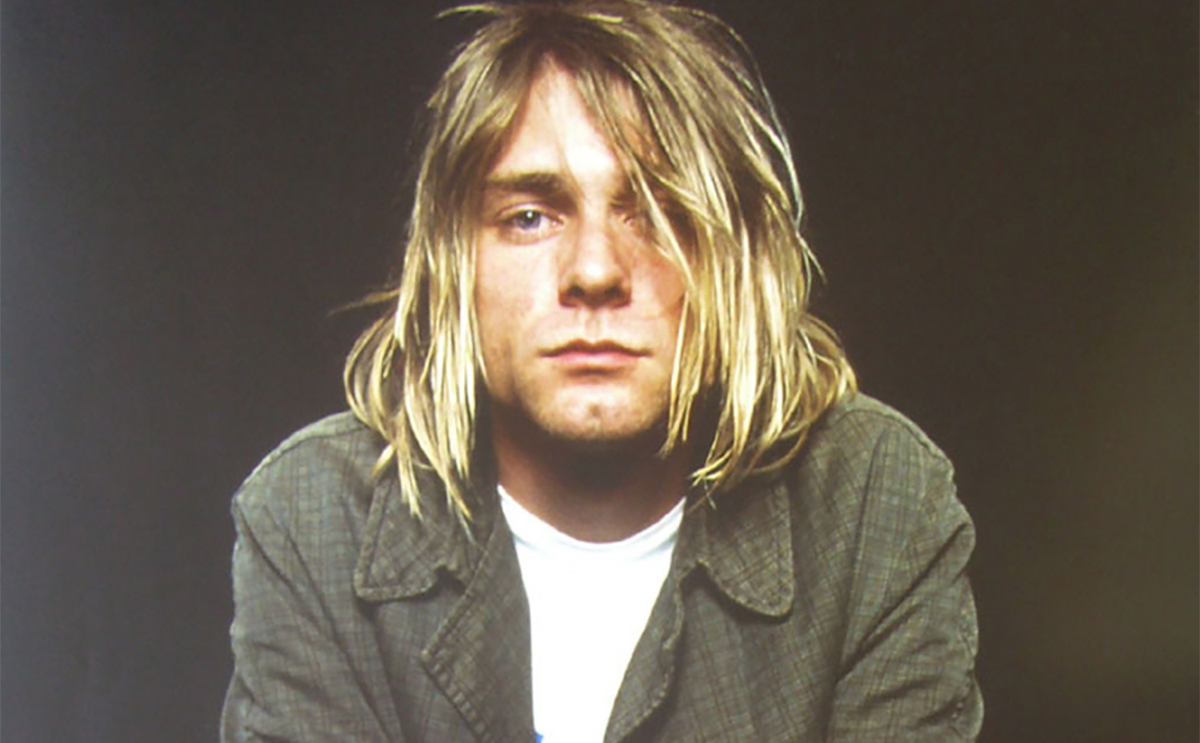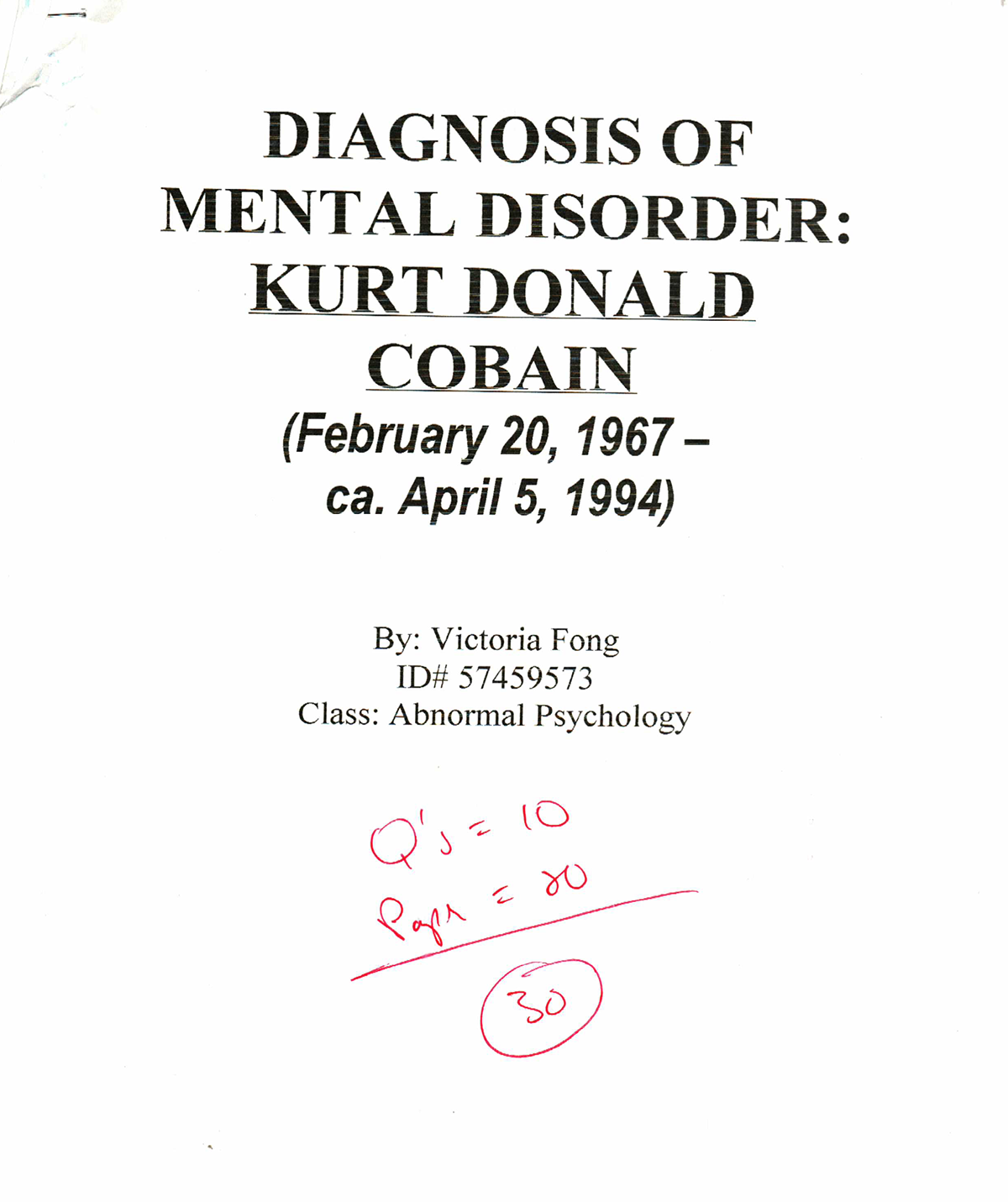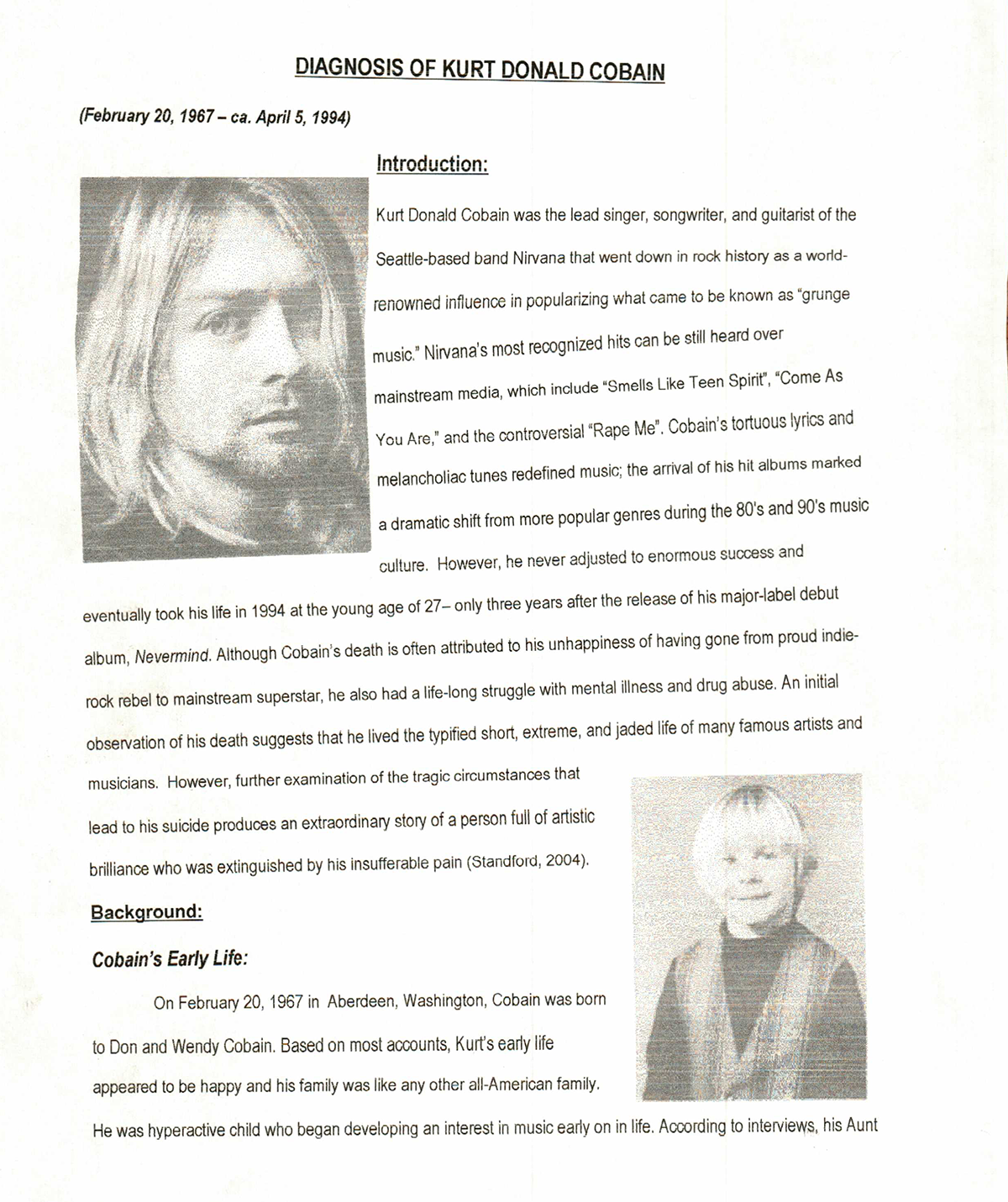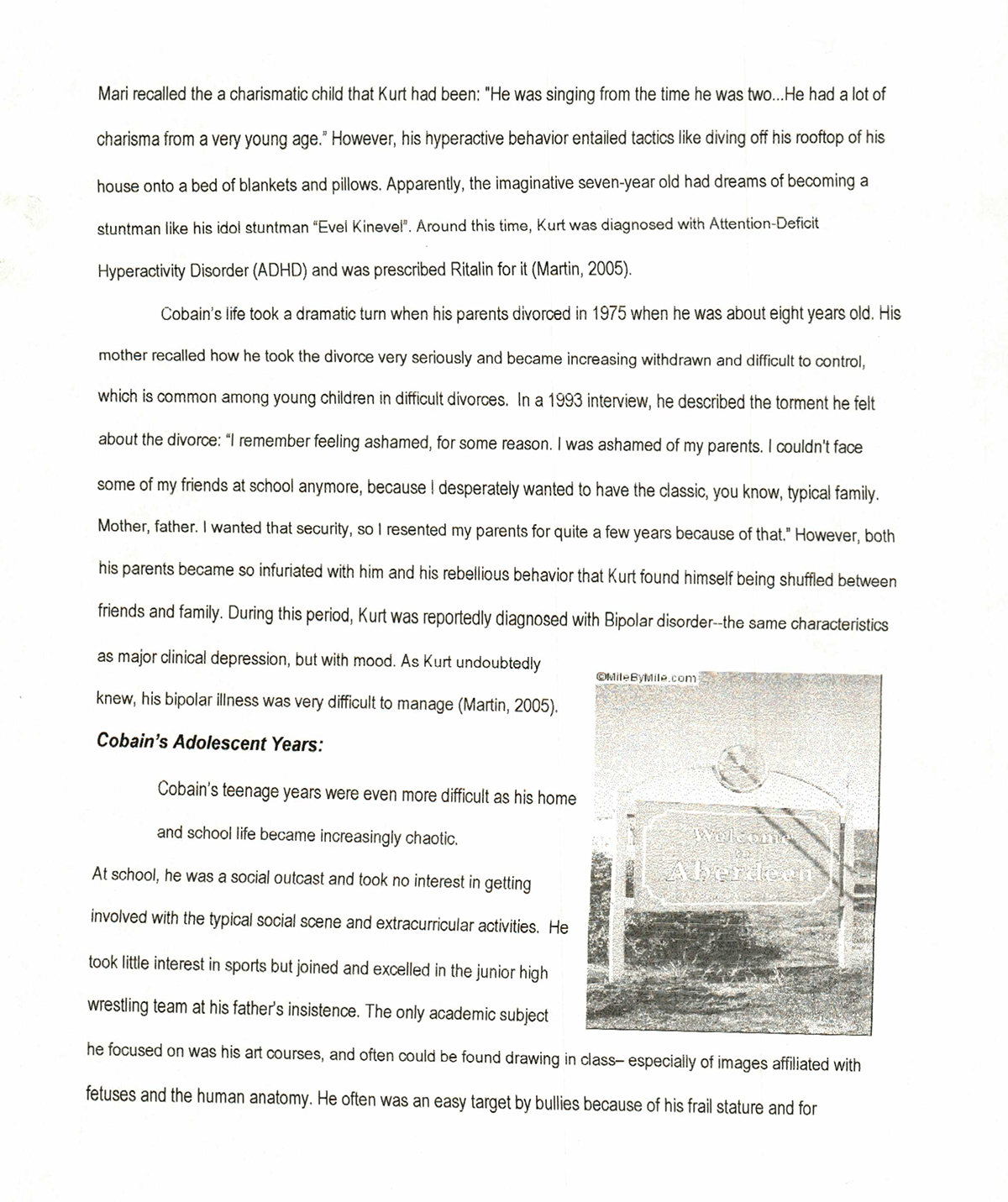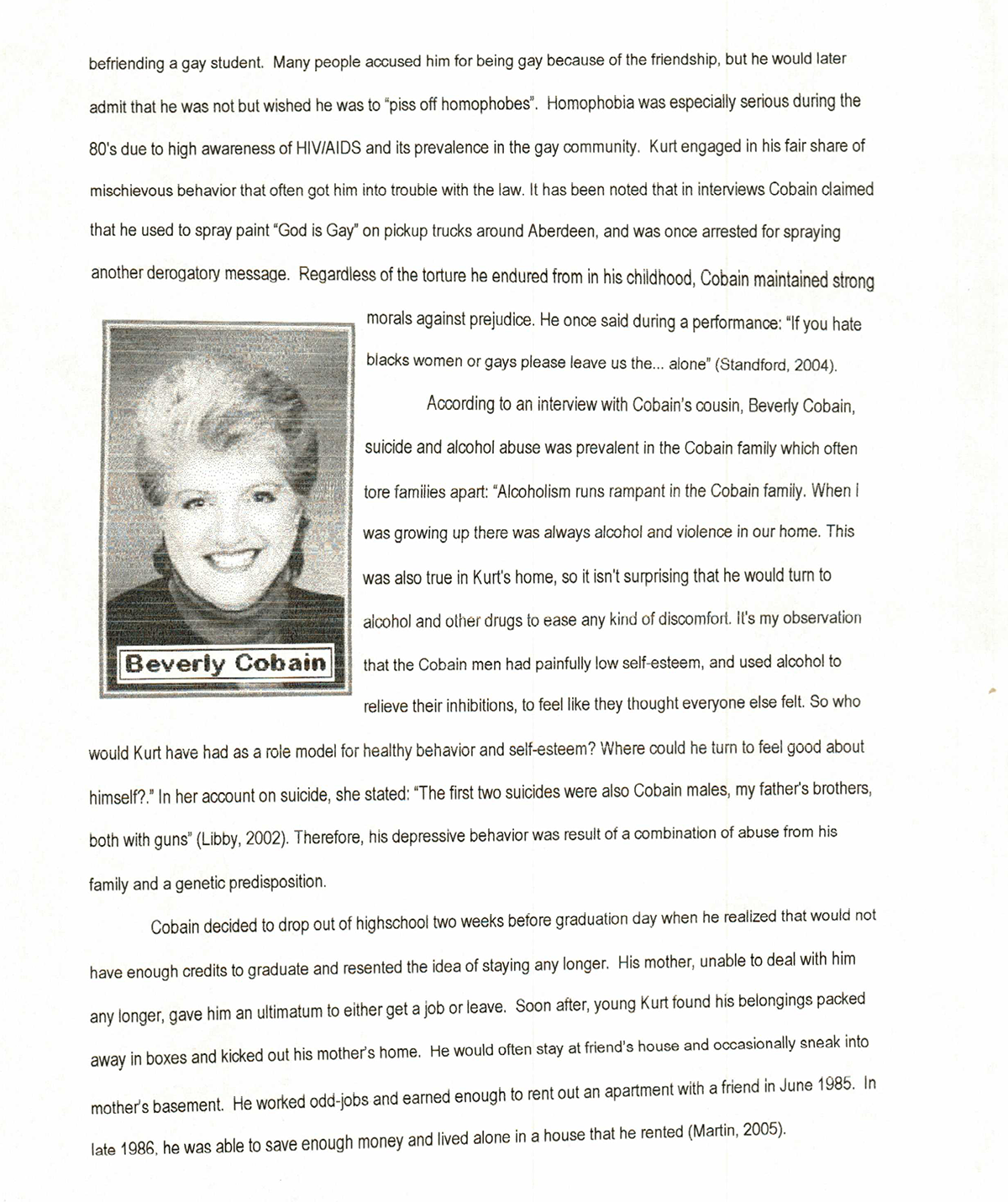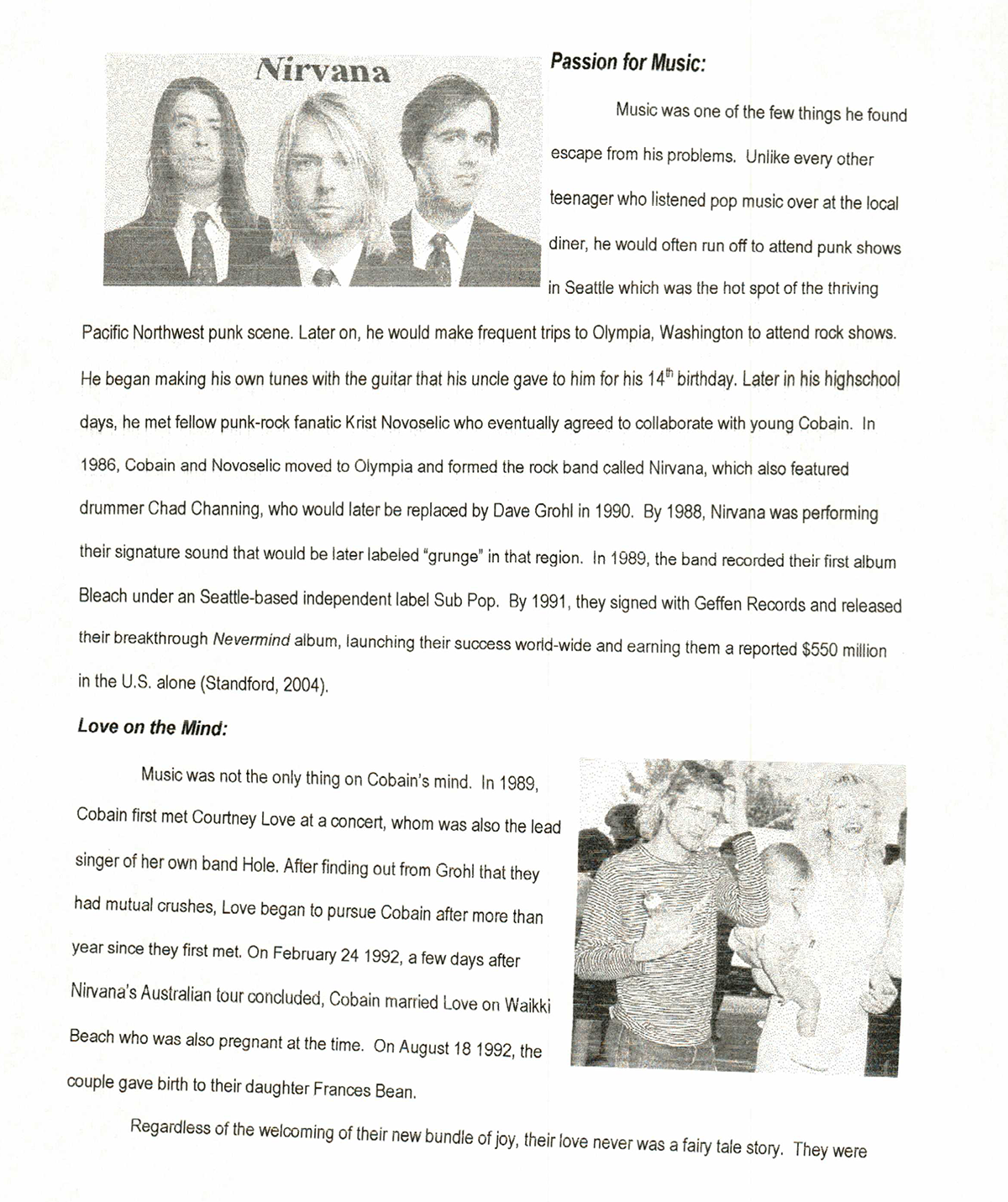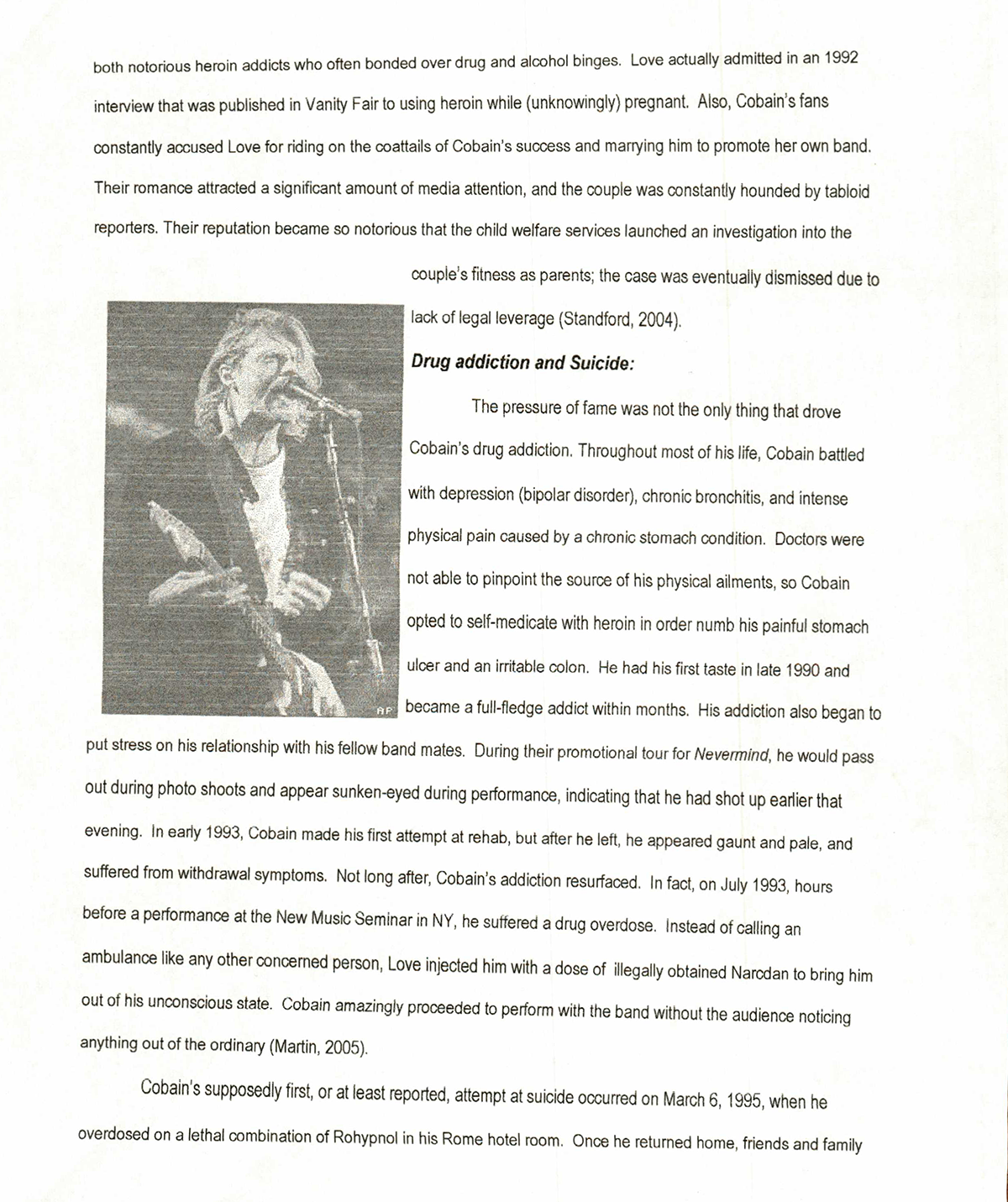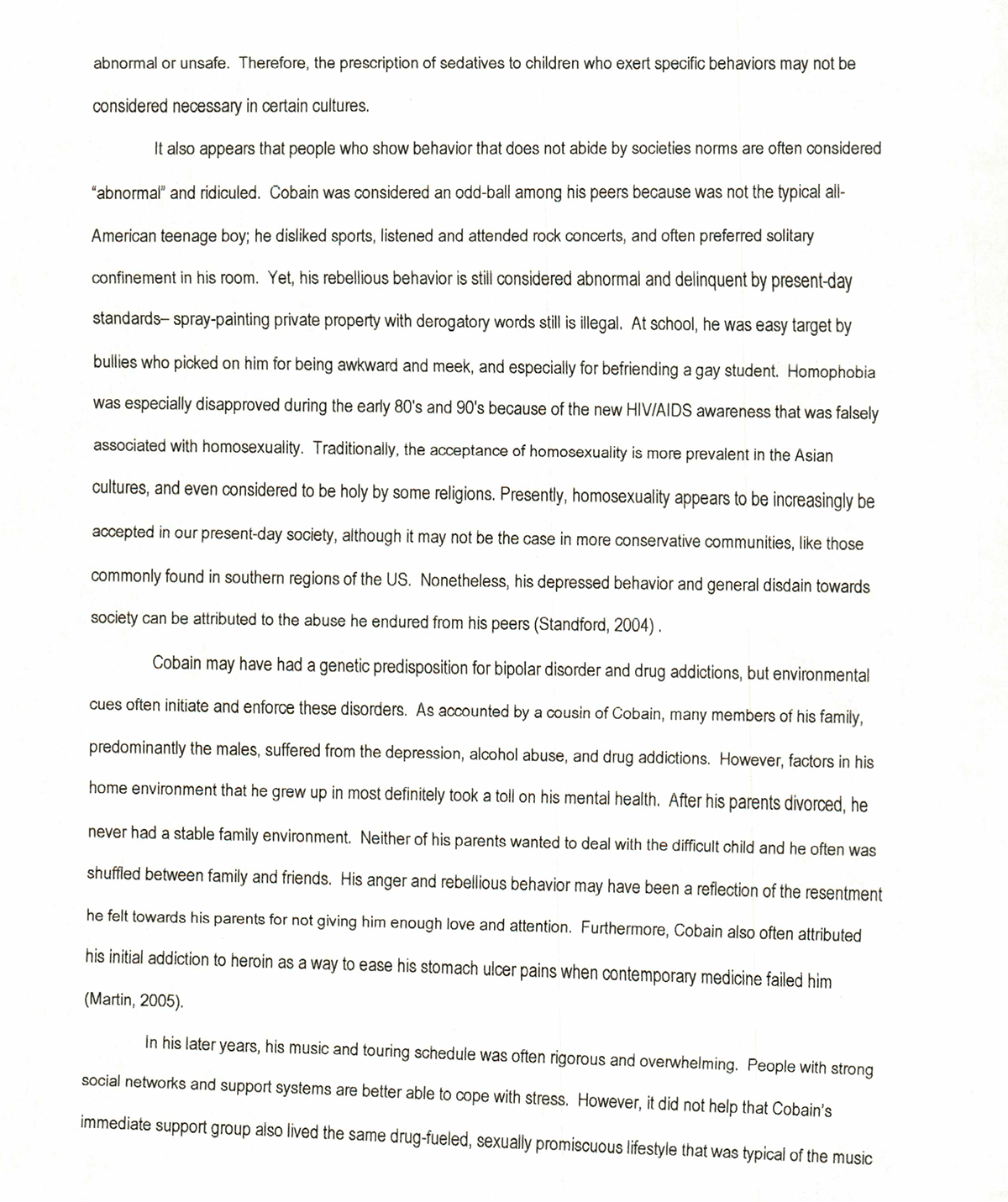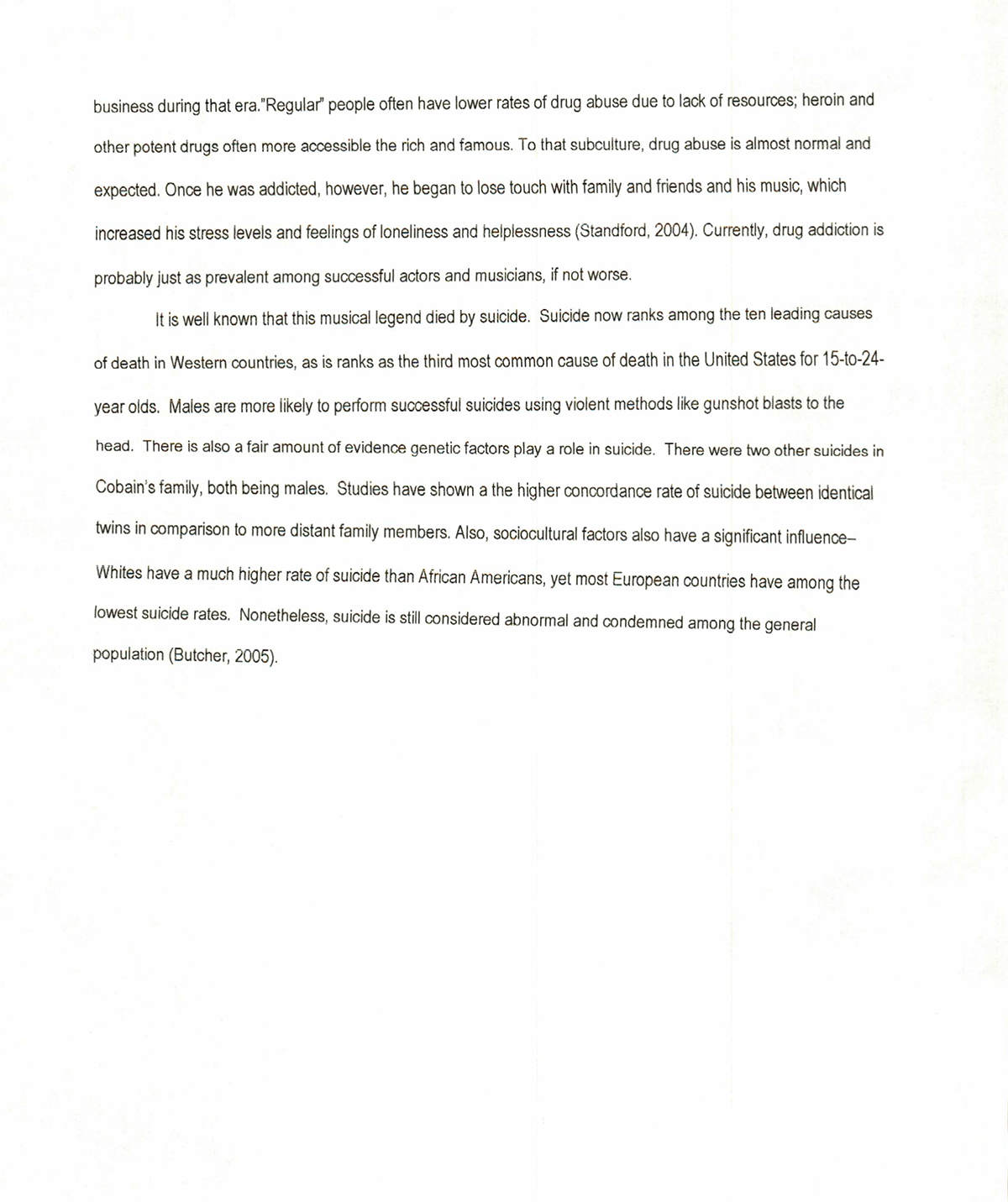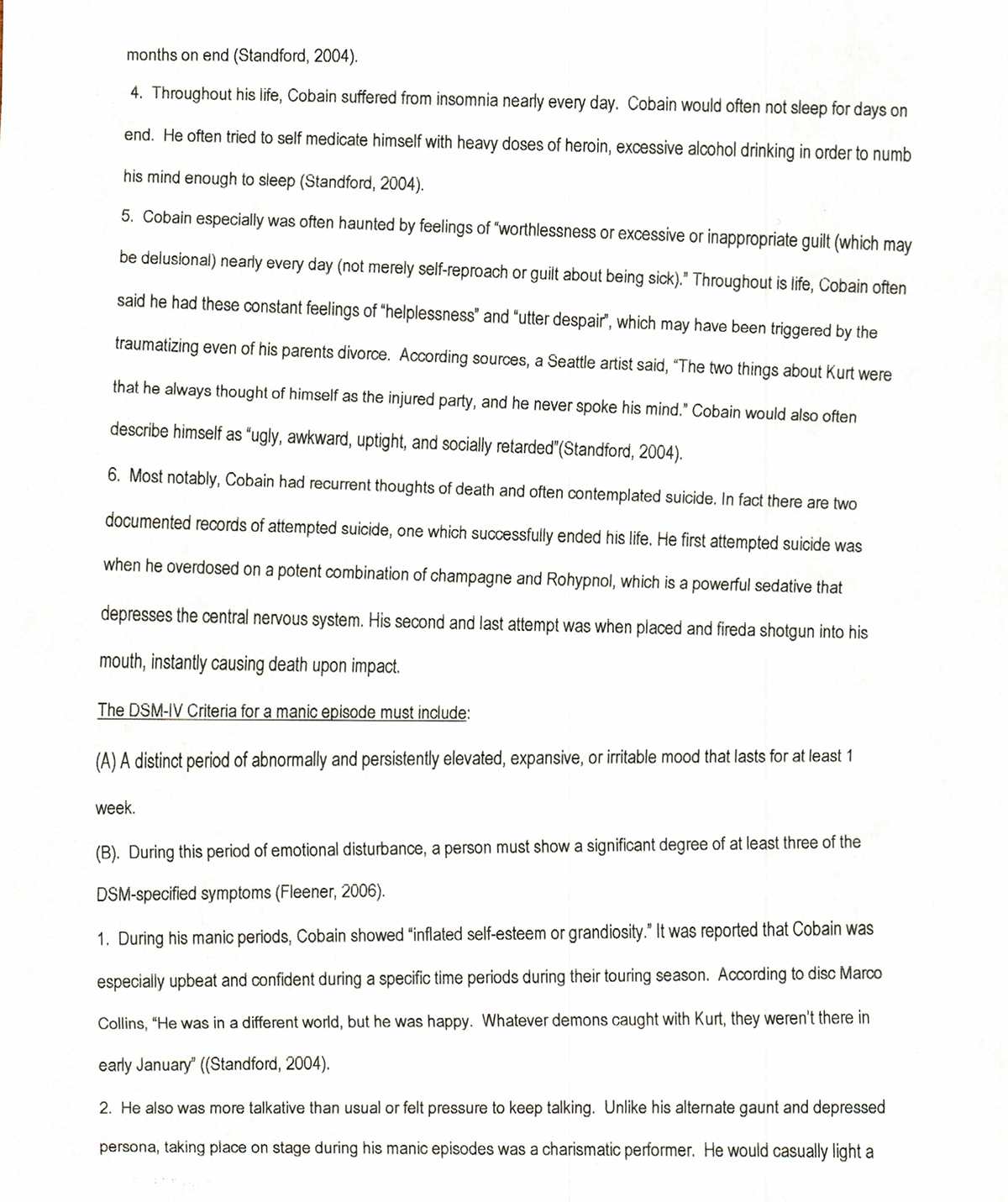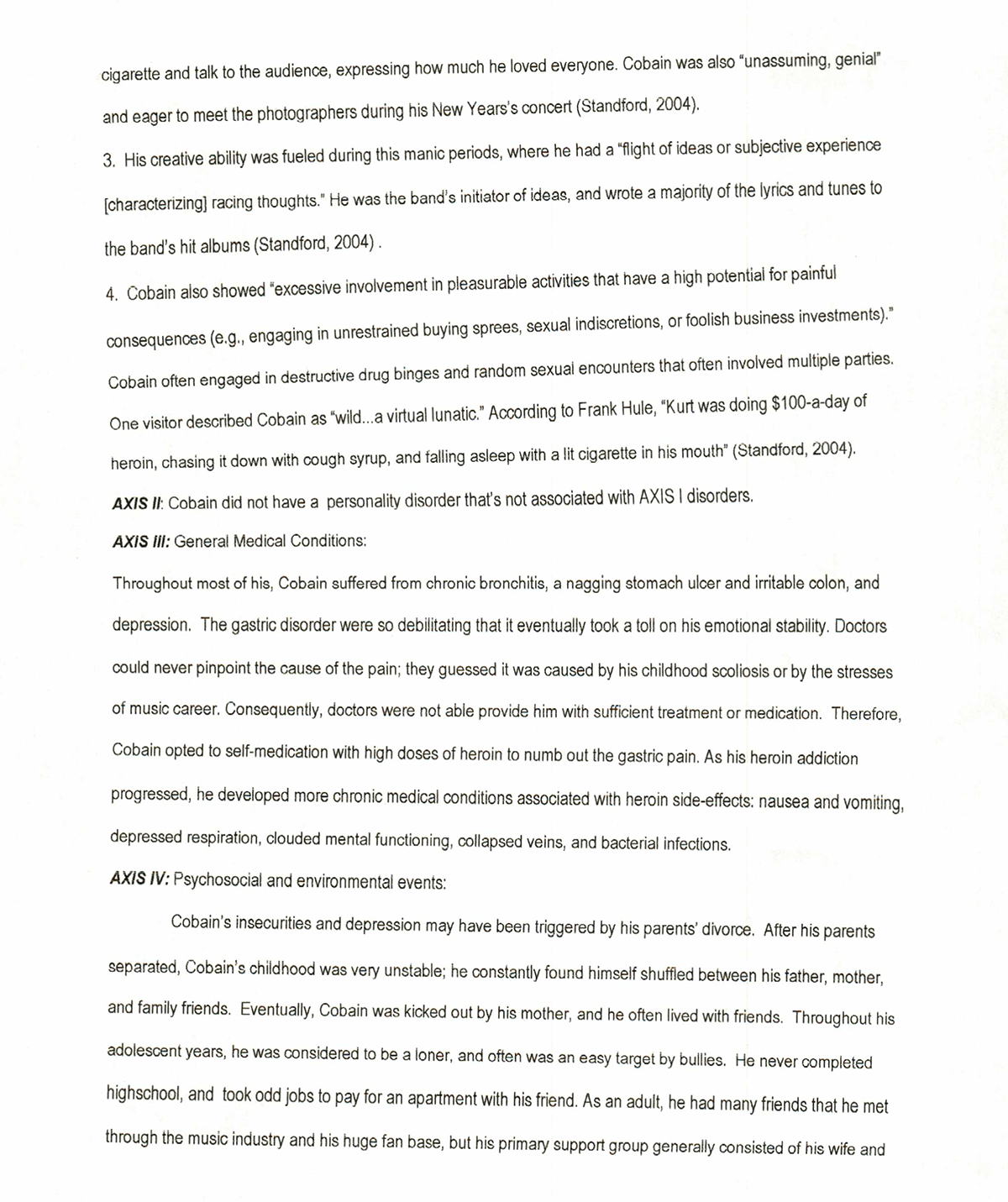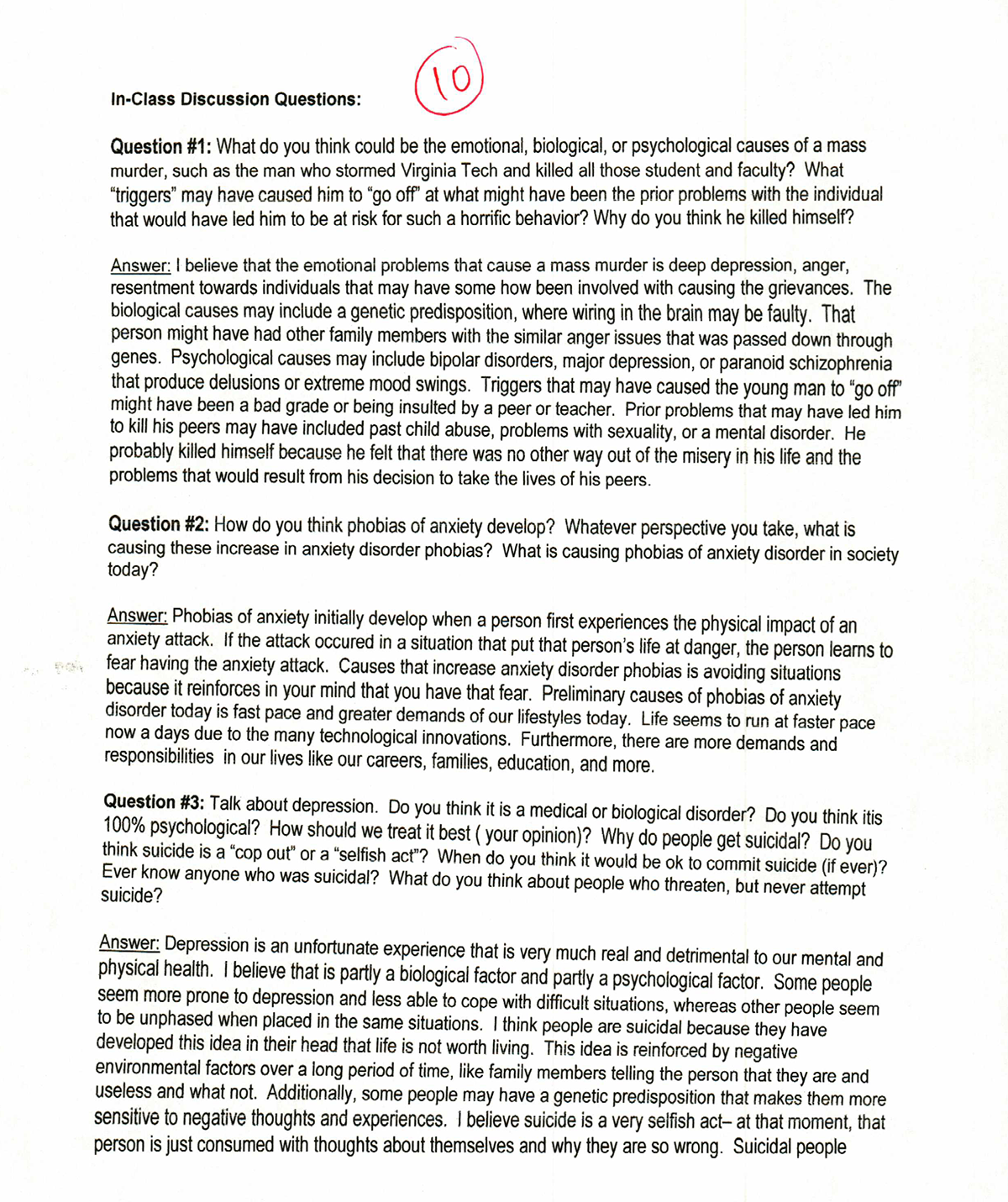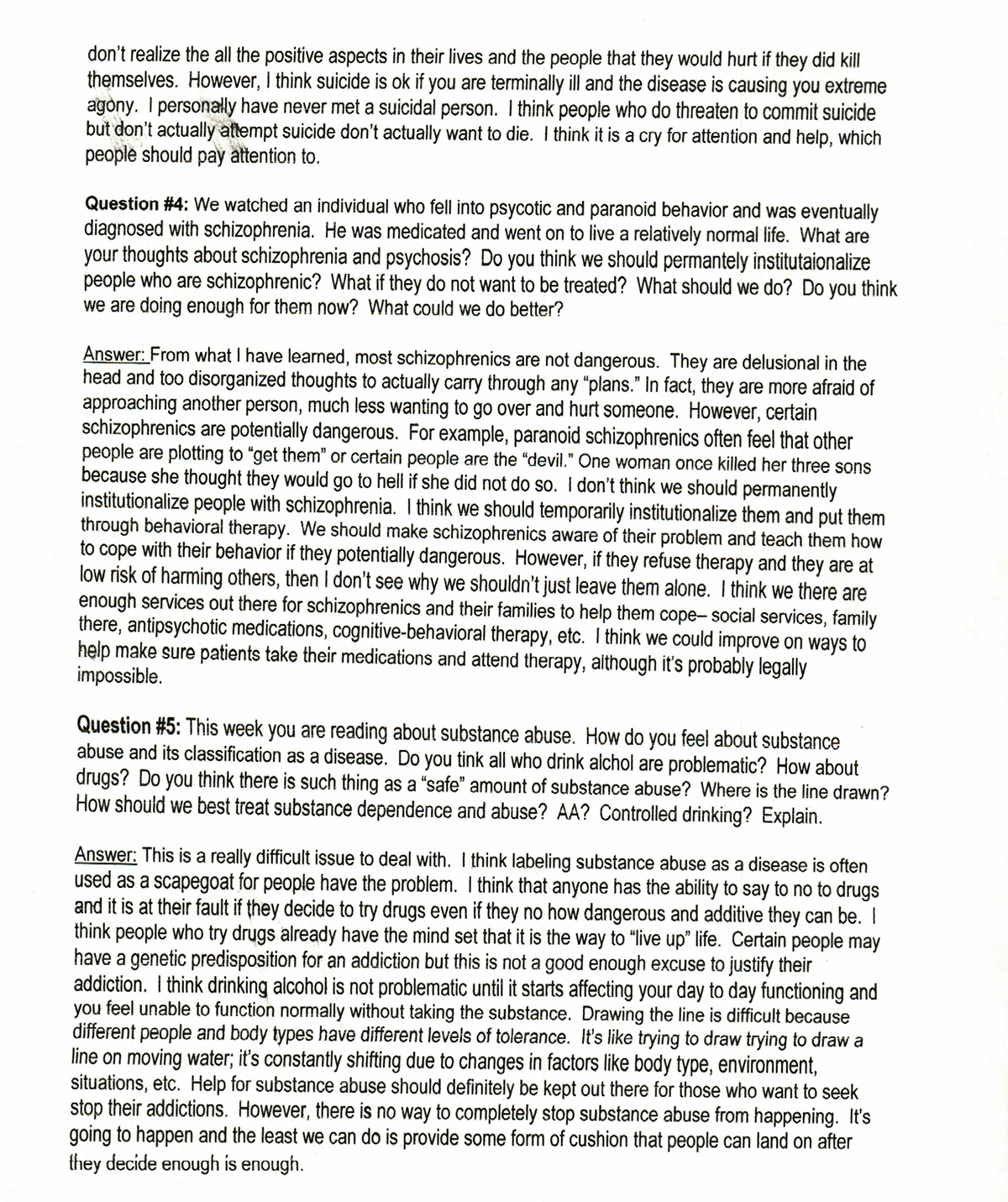For a class on Abnormal Psychology that I took well over a decade ago, and there was an assignment that helped clarify a situation in my family, and ultimately helped me make peace with it. I had to conduct a mental diagnosis on a public figure known to have had a mental disorder using criteria from the Diagnostic and Statistical Manual of Mental Disorders (DSM–5). Although it’s not a professional diagnosis, the core content is still relevant in understanding how mental disorders can develop and progress as a consequence of both external and inherited factors. And possibly to question the use of medication for regulating what society considers "abnormal behavior.” -VF
A Mental Diagnosis of Kurt Donald Cobain
Introduction:
Kurt Donald Cobain was the lead singer, songwriter, and guitarist of the Seattle-based band Nirvana that went down in rock music history as a supernova influence in popularising what would become known as “grunge music.” Nirvana’s most recognized hits can still be heard over mainstream media, which include “Smells like Teen Spirit,” “Come As You Are,” and the controversial “Rape Me.” Cobain’s torturous lyrics and melancholiac tunes redefined music; the arrival of his band’s hit albums marked a dramatic shift from the more hip-hop/pop genres during the ’80s and '90s music culture. However, he never adjusted to the enormous success and eventually took his life in 1994 at the young age of 27 — only three years after the release of his major-label debut album, Nevermind. Although Cobain’s death is often attributed to his unhappiness of having gone from proud indie-rock rebel to mainstream superstar, he also had a life-long struggle with mental illness and drug abuse. An initial observation of his death suggests that he lived the typified short, extreme and jaded life typical of many famous artists and musicians. However, further examination reveals the tragic circumstances that lead to his suicide and the story of an extraordinary person that was extinguished too soon by his insufferable pain (4).
Background:
Cobain’s Early Life
On February 20, 1967, in Aberdeen, Washington, Cobain was born to Don and Wendy Cobain. Based on most accounts, Kurt’s early life appeared to be happy and his family seemed like any other all-American family. He was, however, a particularly hyperactive child who began developing an interest in music early on in life. According to interviews, his Aunt Mari recounted the charismatic child that Kurt had been: “He was singing from the time he was two... He had a lot of charisma from a very young age.” However, his hyperactive behavior entailed tactics like diving off the rooftop of his childhood house onto a seemingly safe pile of blankets and pillows. This imaginative seven-year-old had dreams of becoming a stuntman like his idol stunt performer "Evel Knievel.” Around this time, Kurt was diagnosed with Attention-Deficient Hyperactivity Disorder (ADHD) and was put on Ritalin shortly after (3).
Baby Kurt Cobain (source).
Divorce and Depression
Cobain’s life took a dramatic turn when his parents divorced in 1975 when he was about eight years old. His mother recalled how he took the divorce very seriously and became increasingly withdrawn and defiant. In a 1993 interview, he described the torment he felt about the divorce: “I remember feeling ashamed, for some reason. I was ashamed of my parents. I couldn’t face some of my friends at school anymore, because I desperately wanted to have the classic, you know, typical family. Mother, father. I wanted that security, so I resented my parents for quite a few years because of that.” Unfortunately, both his parents were often infuriated with Cobain’s rebellious behavior, so he often found himself shuffled between friends and extended family members. During this period, Kurt was reportedly diagnosed with Bipolar disorder — it has the same characteristics as major clinical depression, but with manic mood swings. As Kurt undoubtedly knew, his bipolar illness would become increasingly difficult to manage (3).
“I remember feeling ashamed, for some reason. I was ashamed of my parents. I couldn’t face some of my friends at school anymore, because I desperately wanted to have the classic, you know, typical family. Mother, father. I wanted that security, so I resented my parents for quite a few years because of that.”
Cobain’s Adolescent Years
Cobain’s teenage years were even more difficult as his home and school life became increasingly toxic. At school, he was a social outcast who took no interest in getting involved with the typical social scene and extracurricular activities. Despite his lack of interest in sports, he would eventually join and excel in the junior high wrestling team at his father’s insistence. The only academic subject he focused on was his art courses, and he often could be found drawing in class, especially of images affiliated with fetuses and human anatomy. He frequently was an easy target to bullies at school because of his frail stature and for befriending a gay student. And he would often be accused of being gay himself because of the friendship, but he would later admit that he was not but wished he was just to “piss off homophobes.” Unfortunately, at the time, homophobia was particularly prevalent when the US was experiencing the height of the HIV/AIDS crisis with infected individuals predominantly from the gay community (3).
Kurt Cobain's police mug shot from May 1986 (source).
Kurt engaged in his fair share of mischievous behavior that often got him into trouble with the law. It has been noted that in interviews Cobain claimed that he used to spray paint “God is Gay” on pickup trucks around Aberdeen, and was once arrested for spraying another derogatory message. Regardless of the struggles that he endured during his childhood, Cobain maintained strong morals against prejudice. He once said during a performance: “At this point, I have a request for our fans. If any of you in any way hate homosexuals, people of a different color, or women, please do this one favor for us — leave us the fuck alone! Don’t come to our shows and don’t buy our records” (4).
“At this point, I have a request for our fans. If any of you in any way hate homosexuals, people of a different color, or women, please do this one favor for us — leave us the fuck alone! Don’t come to our shows and don’t buy our records.”
Family Matters
According to an interview with Cobain’s cousin, Beverly Cobain, suicide and alcohol abuse were prevalent among members of the Cobain's which often tore families apart: “Alcoholism runs rampant in the Cobain family. When I was growing up there was always alcohol and violence in our home. This was also true in Kurt’s home, so it isn’t’ surprising that he would turn to alcohol and other drugs to ease any kind of discomfort. It’s my observation that the Cobain men had painfully low self-esteem and used alcohol to relieve their inhibitions, to feel like they thought everyone else felt. So who would Kurt have had as a role model for healthy behavior and self-esteem? Where could he turn to feel good about himself?” In her account on his suicide, she had stated: “The first two suicides were also Cobain males: my father’s brothers, both with guns” (2). Based on his family history, it’s highly likely that his maladjusted behavior was a consequence of childhood abuse and neglect, inadequate parenting, as well as a genetic predisposition to depression.
Cobain decided to drop out of high school two weeks before graduation day, realizing that he wouldn’t have enough credits to graduate anyway, and was repelled by the idea of staying any longer. His mother, unable to deal with him any longer, gave him an ultimatum to either get a job or leave. Soon after, young Kurt found his belongings packed away in boxes and kicked out of his mother’s home. He would often stay at a friend’s house and occasionally sneak into his mother’s basement. He worked odd jobs and would earn just enough to rent out an apartment with a friend starting in June 1985. In late 1986, he was able to save enough money to live alone in a house that he rented (3).
Nirvana's Kurt Cobain Credit: Getty (source).
Passion for Music
Music was one of the few things that Kurt found an escape from his problems. Unlike every other teenager at the time who was listening to the latest pop hits over at the local diner, Cobain would often run off to attend punk shows in Seattle, which at the time was a hot spot for a thriving Pacific Northwest punk scene. Later on, he would make frequent trips out to Olympia, Washington to attend rock shows, and write his music with the guitar that his uncle had given him for his 14th birthday. Later in his high school days, he would meet fellow punk-rock fanatic Krist Novoselic who’d eventually agree to collaborate with young Cobain. In 1986, Cobain and Novoselic moved to Olympia and formed what would become the superstar rock band Nirvana. It initially featured drummer Chad Channing, who would be replaced by Dave Grohl in 1990. By 1988, Nirvana was performing their signature sound that would be later labeled “grunge” in that region. In 1989, the band recorded their first album Bleach under a Seattle-based independent label Sub Pop. By 1991, they signed with Geffen Records and released their breakout album Nevermind, launching their success worldwide and earning them a reported $550 million in the U.S. alone (4).
Love on the Mind
Music was not the only thing on Cobain’s mind. In 1989, Cobain met Courtney Love for the first time at a concert, who was also the lead singer of her own band, Hole. After finding out from Cobain’s bandmate Grohl that they had mutual crushes, Love began to pursue Cobain after more than a year since their first meeting. On February 24, 1992, a few days after Nirvana’s Australian tour concluded, Cobain married Love on Waikiki Beach in Hawaii who was also pregnant at the time with their first child. On August 18, 1992, the couple gave birth to their only daughter, Frances Bean Cobain.
Regardless of the welcoming of their new bundle of joy, their love never was a fairy tale story. They were both notorious heroin addicts who often bonded over drug and alcohol binges. Love admitted in a 1992 interview published in Vanity Fair to have been using heroin while (unknowingly) pregnant. Needless to say, their romance attracted a significant amount of media attention, and the couple was constantly hounded by tabloid reporters. Cobain’s fans would often accuse Love for riding on the coattails of Cobain’s success and for marrying him just to promote her band. Their reputation would become so notorious that Child Welfare Services would launch an investigation on the couple’s fitness as parents; the case was eventually dismissed due to the lack of legal leverage (4).
Kurt Cobain and Frances Bean Cobain (source).
Drug Addiction and Interventions
The pressure of fame was just one of the multiple factors that aggravated Cobain’s drug addiction. Throughout most of his life, Cobain struggled with depression (bipolar disorder), chronic bronchitis, and intense physical pain caused by a chronic stomach condition. Doctors were not able to pinpoint the source of his physical ailments, so Cobain often opted to self-medicate with heroin to numb the painful stomach ulcer and irritable colon. He had his first hit in the late 90s and like many, became a full-fledged addict within months. His addiction also began to put stress on his relationship with his fellow bandmates. During their promotional tour for Nevermind, he would pass out during photo shoots and appear sunken-eyed during performances, indicating that he had shot up earlier that evening.
In early 1993, Cobain made his first attempt at rehab; but after he leaving, he would appear gaunt and pale, and suffered from withdrawal symptoms. Not long after, Cobain’s addiction resurfaced. In fact, in July 1993, he suffered another drug overdose just hours before a performance at the New Music Seminar in New York. Instead of calling an ambulance like any other concerned person, Love would inject Cobain with a dose of illegally obtained NARCAN® (naloxone HCl) to bring him out of his unconscious state. Cobain, amazingly enough, would proceed to perform with his band without the audience noticing anything out of the ordinary (3).
Death by Suicide
Cobain’s supposedly first attempt or at least reported attempt at suicide occurred on March 6, 1995, when he overdosed on a lethal combination of the drug Rohypnol and alcohol in his Rome hotel room. Once he returned home, friends and family staged an intervention, and he eventually agreed to check into rehab. However, a few days after arriving, Cobain’s nurses said he would ask to go out to smoke but would leave the facilities by jumping over the walls. He pretty much fell off the radar after taking the next flight back to Seattle. Most of his friends did not how about his whereabouts, and eventually, Love was pushed into filling a missing-persons report and hiring a private investigator, Tom Grant, to find him.
On April 8, 1994, Cobain’s body was discovered in a spare room in his Seattle home by electrician, Gary Smith, who was sent to install security lighting at the time he saw the body. The autopsy report concluded that his death was a result of a “self-inflicted shotgun wound to the head.” The gunshot blast destroyed his head so badly that it was beyond recognition; his body would later be officially identified by his fingerprints. He left behind a suicide note where he addressed his wife Love, his daughter, as well as many of his fans. A toxicology report would later confirm extraordinarily high levels of heroin in his system. And it was estimated that his death was on April 5, 1994. Thousands of fans would attend his funeral and even more mourned his death (4).
The portion of Cobain’s suicide note that addresses his loved ones (source).
Cobain’s Abnormal Behaviour
Attention disorder
As a child, Cobain was diagnosed with Attention Deficit Hyperactive Disorder (ADHD) primarily after pulling dangerous stunts like jumping off rooftops in imitation of Hollywood stunt actors. And apparently, he was often “distracted” and “spoke rapidly.” Consequently, he would be put on Ritalin (methylphenidate) which is a central nervous system stimulant that is clinically reported to produce side-effects including difficulty sleeping, nausea, headaches, lack of hunger (leading to weight loss) and dry mouth. Even though Cobain presented symptoms of clinical ADHD, his behavior as a child may not have necessarily been deemed abnormal or “hyperactive'“ if it hadn’t entailed potentially dangerous consequences or if he was raised in a different environment, which I’ll elaborate on.
Medicated Discipline
Better use of discernment for managing a child’s energetic behavior could have included educating him on the reality of the stunts performed by professional actors, and to provide a safer outlet such as supervised gymnastic classes. The child’s behavior could have at least been curbed to safer limits without the use of brain chemistry-altering medications. But his family also had a history of maladjusted behavioral patterns like alcoholism and poor parenting that probably derailed more productive courses of action. His behavior may have been managed differently if he were raised in a non-western cultural background with alternative standards. For example, the Maasai (East African pastoralists) require all males to kill a lion single-handedly as part of a rite of passage to becoming a Moran — an elite group of young warriors and defenders of the community and its livestock. But in a traditional Asian household, you would have “normally” been disciplined into submission by your primary caretaker, as a psychiatric intervention is generally considered “excessive.”
Brain scans of ADHD subjects (red) vs control subjects (yellow) showing distribution of brain activity: ADHD subjects showed additional unique subcortical activations that included thalamus, brainstem, cerebellum, and hippocampus (source).
The Social Outcast
There often appears to be a common thread among people who display behaviors outside of societal norms to have experienced ridicule from their peers for being “abnormal.” Cobain was considered an oddball among his peers for not being a stereotypical hyper-masculine American teenage boy: he disliked sports; listened to and attended rock concerts; and preferred solitary confinement in his room. However, some of his outright delinquent antics are still considered problematic and illegal by today’s standards, such as spray-painting public property with profanity. At school, he was an easy target to bullies for being “awkward” and “meek”, and for befriending an openly gay student. Homophobia was especially taboo back in the '80s and '90s when the HIV/AIDS epidemic was at its peak and homosexuality was falsely associated as a cause. Traditionally, the acceptance of homosexuality is more prevalent in Asian cultures and even considered to be holy by some religions. Nonetheless, his depressed behavior and general disdain towards society could have been attributed to the abuse he endured by his peers (4).
Genetic vs Environment
Cobain may have had a genetic predisposition to bipolar disorder and drug addictions, but environmental cues often initiate and enforce these disorders. As accounted by his cousin, many members of Cobain’s family, predominantly the males, suffered from depression, alcohol abuse, and drug addictions. However, there were uncontrollable factors in his home environment that could be attributed to his mental breakdown. After his parents divorced, he never truly had a stable family environment. Both his parents would remarry, and his father reportedly spent more time raising his new family which further added to Cobain’s resentment. Neither of his parents wanted to deal with a difficult child and he was frequently shuffled between family and friends; his mother would eventually kick me out of the house. Needless to say, his anger and rebellious behavior were a reflection of how he felt towards his parents for not giving him the love and attention that any child needs to thrive. To add fuel to the pain, Cobain’s initial addiction to heroin was a way to ease stomach ulcers, which may have even been a side-effect of the Ritalin he was forced to take as a child, as well as the buildup of stress caused by all fronts of his life.
Research Article on how suicide may be predicted by epigenetic model (source).
The Tour Life
In his later years, his music production and touring schedule was often rigorous and overwhelming. People with strong social networks and support systems are better able to cope with stress. However, it did not help that Cobain’s immediate support network also lived the same drug-fueled, sexually promiscuous lifestyle that was typical of the music business during that era. "Regular” people often have lower rates of drug abuse due to the lack of resources; heroin, cocaine, and other Schedule 1 narcotics are more prevalent in the social circles of the rich and famous. To that subculture, drug abuse had been (and may still be) almost normal and expected, which Grohl has verified in an interview as a non-user himself. Once Cobain was addicted, however, he began to lose touch with his immediate circle as well as his music, which increased his stress levels, as well as his feelings of loneliness and helplessness (4).
Suicide Ties
It is well known that this music legend died by suicide. Suicide still ranks among the top ten leading causes of death in Western countries; it ranks as the third most common cause of death in the United States for 15 to 24-year-olds. Males are more likely to perform successful suicides using violent methods like gunshot blasts to the head. There is also a fair amount of evidence that genetic factors play a role in suicide. There were two other suicides in Cobain’s family, both being males. Studies have also shown a higher concordance rate of suicide between identical twins in comparison to more distant family members. Also, sociocultural factors have a significant influence — Whites/Caucasians have a higher rate of suicide than African Americans, though most European countries have among the lowest suicide rates. Nonetheless, suicide is still considered abnormal and condemned by the general population (1).
DSM IV Diagnostic Criteria of Bipolar Disorder 1 & 2.
DSM-IV Full Diagnosis of Kurt cobain
Axis 1: Bipolar disorder
This mood disorder is characterized by the occurrence of Major Depressive Episodes and at least one Manic Episode or Mixed Episode (not induced by drugs or another general medical condition).
DSM Criteria for Major Depressive Episode:
(A) To be considered as a major depressive episode, a person must have at least five DSM-indicated symptoms during the same 2-week period and represent a change from a normal predisposition.
(B) At least one of them must be either: (1) a depressed mood or (2) a loss of interest or pleasure (5).
Cobain showed depressed and irritable moods that were confirmed by a personal report of sadness and emptiness and by observations of others. There were dramatic reports that Cobain would spend months binge drinking and engaging in violent behavior like vandalizing property or engaging in fights with fans who he felt were an insult to his music. His cousin, Beverly Cobain, confirmed that he was diagnosed at a young age with Attention Deficit Hyperactive Disorder [ADHD], and then later with bipolar disorder. She said he often had mood swings where he would be complacent at one moment and then angry, irritable, and distracted the next moment (2). His song lyrics, like the one song ”Rape Me,” “I Hate Myself,” and “I want to Die” reflected his anger and mental dysfunction (3).
He showed “markedly diminished interest or pleasure in all, or almost all, activities of the day, nearly every day.” He often felt overwhelmed by the success of his band and the demands that came with it, often feeling disinterested in performing with his band. His widow would later report how desperately unhappy Cobain was with the group; he would say to her, “I hate it. I can’t play with them anymore.” For years, Cobain would often end his concerts by smashing his guitar and amplifier and become wildly angry at the drums and the audience (3).
He also showed significant weight loss (by DSM standards, a change of more than 5% of body weight in a month) as well as fatigue and decreased appetite. Fans said Cobain often appeared gaunt with painfully sunken eyes during concert performances — this was also attributed to his heroin addiction and withdrawal symptoms when he tried to quit. Reportedly, he was considered borderline anorexic and basically would live off only booze and heroin for months on end (4).
Throughout his life, Cobain suffered from insomnia nearly every day. Cobain would often not sleep for days on end. He often tried to self medicate himself with heavy doses of heroin, excessive alcohol drinking to numb his mind enough to sleep (4).
Cobain was often haunted by feelings of “worthlessness or excessive or inappropriate guilt” (which may have been delusional) nearly every day (not merely self-reproach or guilt about being sick). Throughout his life, Cobain often said he had these constant feelings of “helplessness” and “utter despair”, which may have been triggered by the traumatizing event of his parents’ divorce. According to sources, a Seattle artist once made an observation: “The two things about Kurt were that he always thought of himself as the injured party, and he never spoke his mind.” Cobain would also often describe himself as “ugly, awkward, uptight, and socially retarded” (4).
Most notably, Cobain had recurrent thoughts of death and often contemplated suicide. There are two documented records of attempted suicide, one of which successfully ended his life. His first attempt involved an overdose involving a potent combination of alcohol and Rohypnol, which is a powerful sedative that depresses the central nervous system. His second, and final attempt, was when he fired a shotgun into his mouth while intoxicated, instantly causing death upon impact.
The DSM-IV Criteria for a Manic Episode must include:
(A) A distinct period of abnormally and persistently elevated, expansive, or irritable mood that lasts for at least 1 week.
(B) During this period of emotional disturbance, a person must show a significant degree of at least three of the DSM-specified symptoms (5).
During his manic periods, Cobain showed “inflated self-esteem or grandiosity.” It was reported that Cobain was especially upbeat and confident during a specific period of his touring season. According to disc jockey Marco Collins: “He was in a different world, but he was happy. Whatever demons caught with Kurt, they weren’t there in early January” (4). He may also have had Seasonal affective disorder (SAD).
He also was more talkative than usual or felt the pressure to keep talking. Unlike his alternate gaunt and depressed persona, taking place on stage during his manic episodes was a charismatic performer. He would casually lit a cigarette and talk to the audience, expressing how much he loved everyone. Cobain was also “unassuming, genial” and even eager to meet the photographers during his New Year’s concert (4).
His creative ability was fuelled during his manic periods, where he’d have a “flight of ideas or subjective experience [characterized] by racing thoughts.” He was the band’s initiator of ideas and wrote the majority of the lyrics and tunes to the band’s hit albums (4).
Cobain also showed “excessive involvement in pleasurable activities that have a high potential for painful consequences (e.g., engaging in unrestrained buying sprees, sexual indiscretions, or foolish business investments).” Cobain often engaged in destructive drug binges and random sexual encounters that often involved multiple parties. One visitor described Cobain as “wild… a virtual lunatic.” According to Frank Hule, “Kurt was doing $100-a-day of heroin, chasing it down with cough syrup, and falling asleep with a lit cigarette in his mouth” (4).
Axis II: UNAssociated AXIS 1 disorders
Cobain did not have a personality disorder that is not associated with AXIS I disorders.
Axis III: General Medical Conditions
Throughout most of his life, Cobain suffered from chronic bronchitis, a nagging stomach ulcer and irritable colon, and depression. The gastric disorder was so debilitating that it eventually took a toll on his emotional stability. Doctors would never be able to pinpoint the cause of the pain; they guessed it was caused by his childhood scoliosis or by the stresses of his music career. Consequently, doctors were not able to provide him with sufficient treatment or medication. Cobain often opted to self-medicate with high doses of heroin to numb out the gastric pain. As his heroin addiction progressed, he developed more chronic medical conditions associated with the side-effects of heroin abuse: nausea and vomiting, depressed respiration, clouded mental functioning, collapsed veins, and bacterial infections.
AXIS IV: Psychosocial and Environmental Events
Cobain’s insecurities and depression may have been triggered by his parents’ divorce. After his parents separated, Cobain’s childhood was very unstable; he constantly moved between his parents, family members, and friends. Eventually, Cobain was kicked out by his mother, and he often lived with friends Throughout his adolescent years, he was considered to be a loner and often was an easy target to bullies. As an adult, he had many friends that he met through the music industry and a huge fan base, but his primary support group generally consisted of his wife and daughter. However, his wife was often just as high or drunk as he was. Their unstable lifestyle fuelled by drugs and alcohol led to marital problems; the couple was often found at each other's throats. Their home was frequently described as empty and depressing; the walls had no pictures since the couple did not stay at one place long enough to establish a solid foundation. During his musical career, Cobain was surrounded by a fast-paced environment full of drug abuse and sexual promiscuity. Due to these factors in combination with the stresses and demands of performing, Cobain often felt emotionally alone and physically drained.
AXIS V: Global Assessment of Function (GAF)
Cobain was at high risk of hurting himself by serious suicidal act with the expectation of death.
References:
(1) Butcher, J.N. Mineka, S. Hooley, J.M… 2005, Abnormal Psychology Twelfth ed. Boston: Pearson Education, Inc.
(2) Libby, B.. 2002. Special Report: Even in his Youth. Retrieved May 28, 2008, from Blue Cross Blue Shield of Massachusetts. Website: Source.
(3) Martin, M.. 2005. Kurt Cobain. Minnesota: Capstone Press.
(4) Standford, C.. 2004. Kurt Cobain. New York: Carroll & Graf Publishers.
(5) Fleener, P.E. 2006. DSM IV: Bipolar Disorder I. Retrieved May 28, 2007, From Mental Health Today. Website: Source.

